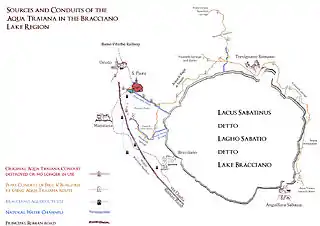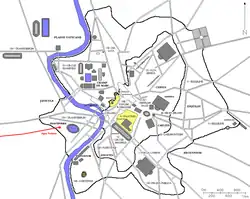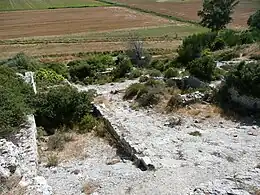Aqua Traiana
The Aqua Traiana (later rebuilt and named the Acqua Paola) was a 1st-century Roman aqueduct built by Emperor Trajan and inaugurated in 109 AD.[1] It channelled water from sources around Lake Bracciano, 40 km (25 mi) north-west of Rome, to ancient Rome. It joined the earlier Aqua Alsietina to share a common lower route into Rome.

It had only fallen into disuse in the 17th century.
History
Frontinus indicated[2] in c. 98 AD that a new aqueduct was being planned, and completion took about a decade. The inauguration of the aqueduct was recorded in the Fasti Ostienses as being dedicated with great fanfare in 109, and stated that the water was tota urbe salientem (issuing throughout the city).
The date of inauguration was also significant for its intended uses, being only a few months before the Naumachia Traiani,[3] the vast, grandstand-encircled pool on west bank of the Tiber, intended for naval spectacles (and only two days after the Baths of Trajan on the Oppian Hill, in the heart of Rome, overlooking the lower Forum Romanum and Colosseum).
Later the Aqua Traiana powered Rome's important flour mills which became critical to its survival during the Gothic Siege of Rome (537–538) when the Janiculum mills were famously put out of action by the Ostrogoths who cut the urban aqueducts. General Belisarius restored the supply of flour by using mills floating in the Tiber.[4] This aqueduct alone was soon repaired[5] but recent excavations revealed that a major branch of the aqueduct (of two) that had powered the mills was never cleared of its blockage from the siege.[6] Nevertheless, the aqueduct continued to supply the Vatican and western regions of Rome until at least the 9th century.[7]
Sources of the aqueduct
The Aqua Traiana was fed by a collection of aquifer sources around the western and northern sides of Lake Bracciano. The sources were identified in the 19th century in the following groups, running clockwise around the lake from Bracciano:[8][9]

- The seven sources in the Villa Flavia / Fosso di Grotta Renara area. These were gathered together into three tanks named by Cassio and Lanciani as Greca, Spineta and Pisciarello. The seventeenth Century architect Carlo Fontana names three tanks as: Botte Greca, Botte Ornava, and Botte Arciprete (Arch-Priest) then places one additional tank further down the Fosso di Grotta Renara as the Botte di Pisciarelli. One tank is currently called 'Fonte Micciaro'.
- The sources in the Fosso di Fiora area: These include the source at the monumental Fiora Nymphaeum, another source at the 'Carestia' Nymphaeum approx 1 km from the Fiora, which now lies in ruin, but is documented by various maps in the Orsini collection.
- A collection of sources at the Vicarello Baths
- One source close to the contemporary Acqua delle Donne Restaurant.
- The Sette Botti (seven tanks) immediately to the East of the Acqua delle Donna.
- Various sources to the north of Monte Rocca Romana in the territory of Bassano Romano and along the Fosso Della Calandrina including the notable Fonte Ceraso.
- The Aquarelli sources to the North East of the Lake.
- The Acqua D'Impolline due East of the Lake.
The yield of various of these sources were measured and compared in the early 1690s.[10]
 Yield of Water Sources in 1692. |
The most significant and copious source of the Aqua Traiana was pinpointed as close to the Fosso di Fiora in the modern district of Manziana.[11]
Subsequently little more was published about the sources for over 150 years probably because of the difficulty of accessing the terrain.
Some additional sources of the Trajan aqueduct were identified in 1999[12] as Acqua Praecilia, located near Manziana.[13] The initial flow of water is enriched along the way by other sources and is carried by the Archi di Boccalupo bridge. At one point there is a hole from which water flows into a collection pool. The height of the Archi di Boccalupo reaches 15 m and it has a brick curtain that alternates with opus reticulatum.
Recent research and in particular publication of the Santa Fiora, the primary source, in 2010 spurred other explorers who have been finding new sources and parts of the network.[14][15]
Distribution of Aqua Traiana within Rome

How distribution was achieved is mostly subject to speculation, but some suggest that the aqueduct crossed the River Tiber on a high bridge in the area of the modern Ponte Sublicio, and curved around the Aventine before heading north to the Oppio.[16]
The aqueduct was found on the Janiculum hill under the present American Academy in Rome by excavations in the 1990s.[17]
It fed a number of water mills on the Janiculum, including a sophisticated mill complex revealed by excavations in the 1990s under the present American Academy in Rome.
Dilapidation and revival as Acqua Paola

Although the Aqua Traiana, along with all the other aqueducts, was cut by the Ostrogoths in 537, it was the only one restored by Belisarius before his departure in 547 in order to supply water to the grain mills.[18] Over the next few centuries it once again fell in to ruin and ceased to function. It was restored a second time around the year 775 by Pope Adrian I as a way of alleviating the need for the Roman people to carry water in casks from the Tiber to supply the fountains at Saint Peter's Basilica.[19] Subsequently, it once again fell into disrepair.
Camillo Borghese, on his accession in 1605 as Pope Paul V, initiated work on rebuilding the Aqua Traiana, supervised from 1609 by Giovanni Fontana. At that time, the Roman suburbs west of the Tiber River, including the Vatican, were suffering from chronic water shortage. The new pope persuaded the Municipality of Rome to pay for the development of an aqueduct to provide a better water supply to that part of the city.
In 1612, the aqueduct was completed. It was initially called the Acqua Sabbatina or Acqua Bracciano, but was renamed Acqua Paola in honour of Paul V.
Not all original Aqua Traiana sources were available to contribute water to the Aqua Paola. The most copious sources at Santa Fiora, for example, had long since been purloined by duke Paolo Giordano Orsini, who had diverted them to power mills and industry in the city of Bracciano.
The fountain at the end of the aqueduct was referred to as "Il Fontanone" – the Big Fountain – because of its size. It was in the form of a free-standing triumphal arch constructed in white marble with granite columns on high socles. Most of the material was pillaged from the Forum of Nerva. Originally, it consisted of three large central arches, separated by columns, and a smaller one on each side. Water gushed into five basins at the base of each arch. The designer was Paul V's usual architect, Flaminio Ponzio. Among the team of sculptors involved was Ippolito Buzzi, who was responsible for the Borghese coat-of-arms, flanked by the Borghese eagle and dragon, and held aloft by putti, it is presumed to Ponzio's design.
Then, in 1690, Pope Alexander VIII commissioned Carlo Fontana, Giovanni's nephew, to enlarge the fountain. Carlo replaced the five small basins with an enormous single one, the Fontana dell'Acqua Paola, which remains to this day. In more recent times, a small garden has been arranged, hidden behind the structure.
See also
References
- Watkins, H. (Spring–Summer 2002). "Colonia Marciana Traiana Thamugadi: Dynasticism in Numidia Thomas". Phoenix. Classical Association of Canada. 56 (1/2): 84–108. doi:10.2307/1192471. JSTOR 1192471.
- Frontinus, de aq. 64, 87–93
- Buzzetti, C. 1968. “Nota sulla topografia dell’Ager Vaticanus.” QITA 5:105–11.
- Procop., Goth. 5.19.8–19
- A. Casio, Corso delle acque antiche, Rome, 1756, t. i. 11. 28, p. 260. The mutilated inscription bearing the words: Belisarius Adquisivit Anno /)..., was found on an arch of the aqueduct at Lake Bracciano) near Vicarello
- Wilson, A.I. 2000. “The Water-Mills on the Janiculum.” MAAR 45:219–46, 232–36.
- Wilson, A.I. 2000. “The Water-Mills on the Janiculum.” MAAR 45:219–46, 239–245
- Alberto Cassio, Corso dell'Aquae Antiche (1756)
- Rodolfo Lanciani, Topografia di Roma Antica. I Commentari di Frontino intorno le acque e gli acquedotti (1881)
- Carlo Fontana, Utilissimo trattato, 1695
- Carlo Fea, 1832, ‘Storia 1. DELLE ACQUA ANTICHE SORGENTI IN ROMA. PERDUTE...’ referring to a document by Luigi Bernini of 1667 to Pope Alexander VII Chigi
- Archi di Boccalupo https://www.sotterraneidiroma.it/sites/archi-di-boccalupo
- Parco Naturale Regionale di Bracciano, acquedotti, https://www.parcobracciano.it/vivere-il-parco/acquedotti/
- Rabun Taylor et al., "New Wine for Old Bottles: New Research on the Sources of the Aqua Traiana" THE WATERS OF ROME, NUMBER NINE: JANUARY 2016
- Rabun Taylor et al. A Recently Discovered Spring Source of the Aqua Traiana at Vicarello, Lazio, American Journal of Archaeology Volume 124, Number 4 October 2020 Pages 659–93 doi:10.3764/aja.124.4.0659 www.ajaonline.org
- Rabun Taylor, Public Needs and Private Pleasures, L'Erma Di Bretschneider; 2000, ISBN 978-8882651008
- Janiculum Mills Excavations, Roman water-mills on the Janiculum Hill, Rome https://users.ox.ac.uk/~corp0057/JaniculumMills.html
- Gregorovius, Ferdinand, History of the City of Rome in the Middle Ages, Vol. 1, (1894) p. 448
- Gregorovius, Ferdinand, History of the City of Rome in the Middle Ages, Vol. 2, (1894) pp. 385–386
- Notes
- Trajan's aqueduct sourced by UK father and son. The Times. 2010-04-29. (Archived by WebCite at https://www.webcitation.org/5pMXD7u8b Archived 2012-11-07 at the Wayback Machine)
- Two-thousand-year-old Roman aqueduct discovered. The Daily Telegraph. 2010-04-29 (Archived by WebCite at https://www.webcitation.org/5pMdTHed1 Archived 2012-11-07 at the Wayback Machine)
- Fea, C., Storia 1. delle acque antiche sorgenti in Roma, perdute..., 1832
External links
- Roman Fountains
- Satellite photo Acqua Paola is the white hemicircle in the center. To the Northeast is San Pietro in Montorio and the Bramante Tempietto.
- Touring Club Italiano, Roma e Dintorni 1965 p. 454
- Il Fontanone Video by Maurizio Meyer My Rome
- Excavation and historical context of Aqua Traiana at Janiculum mills, 1998–1999
- Aqua Trajana in A Topographical Dictionary of Ancient Rome, Samuel Ball Platner (as completed and revised by Thomas Ashby, 1929)
- Video of the underground structure at the source of the Aqua Traiana taken by British film-makers in 2009.
